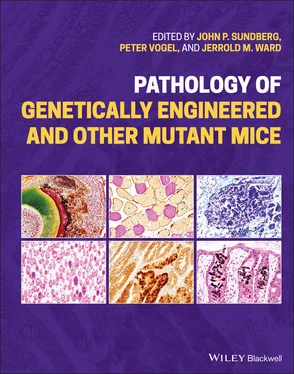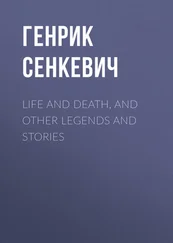Pathology of Genetically Engineered and Other Mutant Mice
Здесь есть возможность читать онлайн «Pathology of Genetically Engineered and Other Mutant Mice» — ознакомительный отрывок электронной книги совершенно бесплатно, а после прочтения отрывка купить полную версию. В некоторых случаях можно слушать аудио, скачать через торрент в формате fb2 и присутствует краткое содержание. Жанр: unrecognised, на английском языке. Описание произведения, (предисловие) а так же отзывы посетителей доступны на портале библиотеки ЛибКат.
- Название:Pathology of Genetically Engineered and Other Mutant Mice
- Автор:
- Жанр:
- Год:неизвестен
- ISBN:нет данных
- Рейтинг книги:3 / 5. Голосов: 1
-
Избранное:Добавить в избранное
- Отзывы:
-
Ваша оценка:
- 60
- 1
- 2
- 3
- 4
- 5
Pathology of Genetically Engineered and Other Mutant Mice: краткое содержание, описание и аннотация
Предлагаем к чтению аннотацию, описание, краткое содержание или предисловие (зависит от того, что написал сам автор книги «Pathology of Genetically Engineered and Other Mutant Mice»). Если вы не нашли необходимую информацию о книге — напишите в комментариях, мы постараемся отыскать её.
An updated and comprehensive reference to pathology in every organ system in genetically modified mice Pathology of Genetically Engineered and Other Mutant Mice
Pathology of Genetically Engineered and Other Mutant Mice
Pathology of Genetically Engineered and Other Mutant Mice — читать онлайн ознакомительный отрывок
Ниже представлен текст книги, разбитый по страницам. Система сохранения места последней прочитанной страницы, позволяет с удобством читать онлайн бесплатно книгу «Pathology of Genetically Engineered and Other Mutant Mice», без необходимости каждый раз заново искать на чём Вы остановились. Поставьте закладку, и сможете в любой момент перейти на страницу, на которой закончили чтение.
Интервал:
Закладка:
29 29 Naf, D., Krupke, D.M., Sundberg, J.P. et al. (2002). The Mouse Tumor Biology Database: a public resource for cancer genetics and pathology of the mouse. Cancer Res. 62 (5): 1235–1240.
30 30 Mikaelian, I., Nanney, L.B., Parman, K.S. et al. (2004). Antibodies that label paraffin‐embedded mouse tissues: a collaborative endeavor. Toxicol. Pathol. 32 (2): 181–191.
31 31 Morse, H.C. 3rd, Anver, M.R., Fredrickson, T.N. et al. (2002). Bethesda proposals for classification of lymphoid neoplasms in mice. Blood 100 (1): 246–258.
32 32 Kogan, S.C., Ward, J.M., Anver, M.R. et al. (2002). Bethesda proposals for classification of nonlymphoid hematopoietic neoplasms in mice. Blood 100 (1): 238–245.
33 33 Sundberg, J.P., Berndt, A., Sundberg, B.A. et al. (2011). The mouse as a model for understanding chronic diseases of aging: the histopathologic basis of aging in inbred mice. Pathobiol. Aging Age Relat. Dis. 1: 7179.
34 34 Berndt, A., Cario, C.L., Silva, K.A. et al. (2011). Identification of Fat4 and Tsc22d1 as novel candidate genes for spontaneous pulmonary adenomas. Cancer Res. 71 (17): 5779–5791.
35 35 NCBI Resource Coordinators (2016). Database resources of the National Center for Biotechnology Information. Nucleic Acids Res. 44 (D1): D7–D19.
36 36 NCBI Resource Coordinators (2015). Database resources of the National Center for Biotechnology Information. Nucleic Acids Res. 43 (Database issue): D6–D17.
37 37 Blake, J.A., Eppig, J.T., Kadin, J.A. et al. (2017). Mouse Genome Database (MGD)‐2017: community knowledge resource for the laboratory mouse. Nucleic Acids Res. 45 (D1): D723–D729.
38 38 Keane, T.M., Goodstadt, L., Danecek, P. et al. (2011). Mouse genomic variation and its effect on phenotypes and gene regulation. Nature 477 (7364): 289–294.
39 39 Yalcin, B., Wong, K., Agam, A. et al. (2011). Sequence‐based characterization of structural variation in the mouse genome. Nature 477 (7364): 326–329.
40 40 Klement, J.F., Matsuzaki, Y., Jiang, Q.J. et al. (2005). Targeted ablation of the Abcc6 gene results in ectopic mineralization of connective tissues. Mol. Cell. Biol. 25 (18): 8299–8310.
41 41 Berndt, A., Li, Q., Potter, C.S. et al. (2013). A single‐nucleotide polymorphism in the Abcc6 gene associates with connective tissue mineralization in mice similar to targeted models for pseudoxanthoma elasticum. J. Invest. Dermatol. 133 (3): 833–836.
42 42 Li, Q., Guo, H., Chou, D.W. et al. (2014). Mouse models for pseudoxanthoma elasticum: genetic and dietary modulation of the ectopic mineralization phenotypes. PLoS One 9 (2): e89268.
43 43 Li, Q., Philip, V.M., Stearns, T.M. et al. (2019). Quantitative trait locus and integrative genomics revealed candidate modifier genes for ectopic mineralization in mouse models of pseudoxanthoma elasticum. J. Invest. Dermatol. 139 (12): 2447–2457.e7.
44 44 Dolney, D.E., Szalai, G., and Felder, M.R. (2001). Differences in charge and kinetic properties of alcohol dehydrogenase 4 from C57BL/6 mice compared to other inbred strains are associated with a cysteine120 to arginine120 substitution. Biochem. Genet. 39 (7–8): 239–250.
45 45 Sundberg, J.P., Taylor, D., Lorch, G. et al. (2011). Primary follicular dystrophy with scarring dermatitis in C57BL/6 mouse substrains resembles central centrifugal cicatricial alopecia in humans. Vet. Pathol. 48 (2): 513–524.
46 46 Brommage, R., Powell, D.R., and Vogel, P. (2019). Predicting human disease mutations and identifying drug targets from mouse gene knockout phenotyping campaigns. Dis. Mod. Mech. 12 (5): dmm038224.
47 47 Meehan, T.F., Conte, N., West, D.B. et al. (2017). Disease model discovery from 3,328 gene knockouts by The International Mouse Phenotyping Consortium. Nat. Genet. 49 (8): 1231–1238.
48 48 Low, B.E., Krebs, M.P., Joung, J.K. et al. (2014). Correction of the Crb1rd8 allele and retinal phenotype in C57BL/6N mice via TALEN‐mediated homology‐directed repair. Invest. Ophthalmol. Vis. Sci. 55 (1): 387–395.
49 49 Elmore, S.A., Cardiff, R., Cesta, M.F. et al. (2018). A review of current standards and the evolution of histopathology nomenclature for laboratory animals. ILAR J. 59 (1): 29–39.
50 50 Dickinson, M.E., Flenniken, A.M., Ji, X. et al. (2016). High‐throughput discovery of novel developmental phenotypes. Nature 537 (7621): 508–514.
51 51 Moore, B.A., Leonard, B.C., Sebbag, L. et al. (2018). Identification of genes required for eye development by high‐throughput screening of mouse knockouts. Commun. Biol. 1: 236.
52 52 Rozman, J., Rathkolb, B., Oestereicher, M.A. et al. (2018). Identification of genetic elements in metabolism by high‐throughput mouse phenotyping. Nat. Commun. 9 (1): 288.
53 53 Sundberg, J.P., Dadras, S.S., Silva, K.A. et al. (2017). Systematic screening for skin, hair, and nail abnormalities in a large‐scale knockout mouse program. PLoS One 12 (7): e0180682.
54 54 Wang, T., Bu, C.H., Hildebrand, S. et al. (2018). Probability of phenotypically detectable protein damage by ENU‐induced mutations in the Mutagenetix database. Nat. Commun. 9 (1): 441.
55 55 Wang, T., Zhan, X., Bu, C.H. et al. (2015). Real‐time resolution of point mutations that cause phenovariance in mice. Proc. Natl. Acad. Sci. U.S.A. 112 (5): E440–E449.
56 56 Bogue, M.A., Philip, V.M., Walton, D.O. et al. (2020). Mouse Phenome Database: a data repository and analysis suite for curated primary mouse phenotype data. Nucleic Acids Res. 48 (D1): D716–D723.
57 57 Schofield, P.N., Bard, J.B., Boniver, J. et al. (2004). Pathbase: a new reference resource and database for laboratory mouse pathology. Radiat. Prot. Dosim. 112 (4): 525–528.
58 58 Schofield, P.N., Gruenberger, M., and Sundberg, J.P. (2010). Pathbase and the MPATH ontology. Community resources for mouse histopathology. Vet. Pathol. 47 (6): 1016–1020.
59 59 Hayamizu, T.F., Mangan, M., Corradi, J.P. et al. (2005). The Adult Mouse Anatomical Dictionary: a tool for annotating and integrating data. Genome Biol. 6 (3): R29.
60 60 Schofield, P.N., Sundberg, J.P., Sundberg, B.A. et al. (2013). The mouse pathology ontology, MPATH; structure and applications. J. Biomed. Semantics 4 (1): 18.
61 61 Fisher, H.M., Hoehndorf, R., Bazelato, B.S. et al. (2016). DermO; an ontology for the description of dermatologic disease. J. Biomed. Semantics 7: 38.
62 62 Sundberg, B.A., Schofield, P.N., Gruenberger, M., and Sundberg, J.P. (2009). A data‐capture tool for mouse pathology phenotyping. Vet. Pathol. 46 (6): 1230–1240.
63 63 Sundberg, J.P., Sundberg, B.A., and Schofield, P. (2008). Integrating mouse anatomy and pathology ontologies into a phenotyping database: tools for data capture and training. Mamm. Genome 19 (6): 413–419.
64 64 Keenan, C.M., Baker, J.F., Bradley, A.E. et al. (2015). International Harmonization of Nomenclature and Diagnostic Criteria (INHAND) progress to date and future plans. Toxicol. Pathol. 28 (1): 51–53.
65 65 Keenan, C.M., Baker, J., Bradley, A. et al. (2015). International Harmonization of Nomenclature and Diagnostic Criteria (INHAND): progress to date and future plans. Toxicol. Pathol. 43 (5): 730–732.
66 66 Maronpot, R.R., Boorman, G.A., and Gaul, B.W. (1999). Pathology of the Mouse. Vienna, IL: Cache River Press.
67 67 Suttie, A.W., Leininger, J.R., and Bradley, A.E. (2017). Boorman's Pathology of the Rat, 2e. San Diego: Academic Press.
68 68 Rowe, D.W., Adams, D.J., Hong, S.H. et al. (2018). Screening gene knockout mice for variation in bone mass: analysis by μCT and histomorphometry. Curr. Osteoporos Rep. 16 (2): 77–94.
69 69 DiTommaso, T., Jones, L.K., Cottle, D.L. et al. (2014). Identification of genes important for cutaneous function revealed by a large scale reverse genetic screen in the mouse. PLoS Genet. 10 (10): e1004705.
Читать дальшеИнтервал:
Закладка:
Похожие книги на «Pathology of Genetically Engineered and Other Mutant Mice»
Представляем Вашему вниманию похожие книги на «Pathology of Genetically Engineered and Other Mutant Mice» списком для выбора. Мы отобрали схожую по названию и смыслу литературу в надежде предоставить читателям больше вариантов отыскать новые, интересные, ещё непрочитанные произведения.
Обсуждение, отзывы о книге «Pathology of Genetically Engineered and Other Mutant Mice» и просто собственные мнения читателей. Оставьте ваши комментарии, напишите, что Вы думаете о произведении, его смысле или главных героях. Укажите что конкретно понравилось, а что нет, и почему Вы так считаете.












